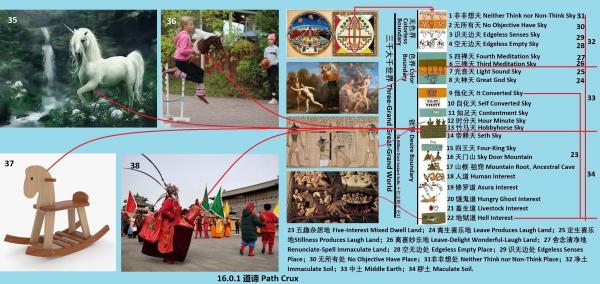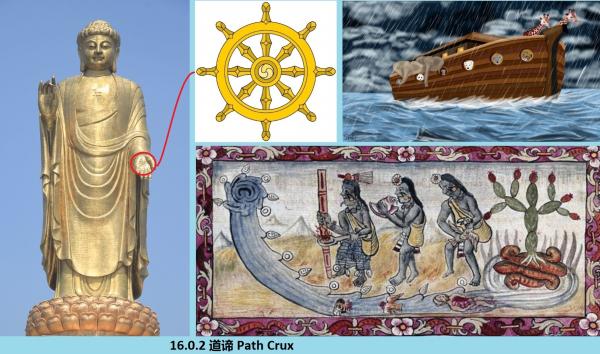| 16 道諦 Path Crux |
| 送交者: 盧岩 2024年03月14日19:23:20 於 [彩虹之約] 發送悄悄話 |
|
道諦的目錄 Catalog of Path Crux:16.1 極喜地 Bliss Heartland;16.2 離垢地 Leave Filth Heartland;16.3 發光地 Glory Heartland;16.4 焰慧地 Flaming Gnosis Heartland;16.5 難勝地 Onerous Heartland;16.6 現前地 Manifestation Heartland;16.7 遠行地 Hike Heartland;16.8 不動地 Immovability Heartland;16.9 善慧地 Benevolent Gnosis Heartland;16.10 法雲地 Juristic Cloud Heartland.
道諦講通往涅槃的道路。塵世人成佛要經歷三大阿僧脂劫。脂是脂肪,是動物抗病害、耐寒、越冬的能量儲備,古人用其來指標成佛的福德資本。劫是劫跛、跛腳、顛簸義,古人亦作大時。 Path Crux talks about the path to salvation. For a mortal to become a Buddha, he or she has to go through three A Monk Index Catastrophes. Catastrophe means lame, and bumpy, ancients also considered it as Big Time. 第一阿僧脂劫是從無始以來,到懂得四聖諦的道理後發菩提心,登上菩薩初地。什麼是發菩提心?發菩提心,即立下此四宏誓言:眾生無邊誓願度;煩惱無盡誓願斷;法門無量誓願學;佛道無上誓願成。發菩提心後,行者成為初地菩薩。菩薩是梵語,義為真人。 The first “A Monk Index Catastrophe” is from beginningless time to when one understands the Four Victorious Cruxes, and arouses Bodhicitta, so aboard the first land of Bodhisattva. Bodhicitta is a Sanskrit word, means enlightened heart. Bodhi means perception, enlightenment. To arouse Bodhicitta is to make the four great vows: Sentient beings are edgeless, I vow: I ferry them all! Annoyances are endless, I vow I sever them all! Juristic doors are limitless, I vow I study them all! Buddha’s path is non-upper, I vow I endeavour to succeed! After arousing bodhicitta, the migrator becomes the first land bodhisattva. Bodhisattva is a Sanskrit word, meaning real human. 第二阿僧脂劫是從發菩提心登上菩薩初地至於第七地。這個階段的行人常常把自己看做補特伽羅。補特伽羅是梵語,義為習氣疙瘩,漢譯為竹馬(如圖16.0.1-13、36、37、38),歐洲人亦作獨角馬(如圖16.0.1-35)。 The second “A Monk Index Catastrophe” is from arousing Bodhi Heart, aboard the first land of bodhisattva to the seventh land. Migrators at this stage often think of themselves as a Pudgala. Pudgala is a Sanskrit word meaning a chunk of habits, translated in Chinese as Hobbyhorse (see Figs. 16.0-13, 36, 37, and 38), and also used by Europeans as unicorn (see Fig. 35).
第三阿僧脂劫是從七地菩薩發起金鋼喻定,出塵,登第八地成為摩訶薩,以至於第十地,盡未來際。金鋼喻定,亦作金鋼橋,金剛無間道;行者也可以通過閱讀 “到達方舟” 來實現這一功能。摩訶薩是梵語,義為大菩薩,大真人。 The third “A Monk Index Catastrophe” is when the Bodhisattva on the seventh land arouses “Philosopher-Stone Metaphor Stillness”, ousting dusts completely, ascends to the eighth land, and becomes a Mahasattva, up to the tenth land, so on to the exhaustion of time. The “Philosopher-Stone Metaphor Stillness”, also known as the “Philosopher-Stone Bridge”, “Philosopher-Stone Non-Intermittent Path”, “The Big Flood”; readers also can do this by reading the “Arrival Ark". Mahasattva is a Sanskrit word meaning great bodhisattva, great real human. 簡單地說,道諦即菩薩以此十地為依為持,修行十渡,斷十重障,證十真如,成就無上正等正覺(梵語是啊褥多羅三藐三菩提)。 To put it simply, Path Crux means that the bodhisattva uses these ten lands as the basis for holding, practicing the ten Arks, breaking the ten hindrances, testifying the ten true suchness, and achieving Non-Upper Correct-Equality Correct-Perception, which in Sanskrit is Anuttara Samyak Sambodhi. 16.1 極喜地 Bliss Heartland《成唯識論》中,唐三藏說:具證二空(2),初獲聖性(3),發菩提心,能益自他,生大喜,故名極喜地(1)。 In "Treatise of Establishing Sense-Only", Tang Tripitaka said: “Having proved the two emptiness-es (2), initially attained the holy nature (3), aroused bodhicitta, can benefit oneself and others, so give rise to great joy, hence the Bliss Heartland (1).
注16.1-1,什麼是地?大乘教以此類十地總攝有為無為(參見11.6.4節《離系果》)功德以為自性,與所修行為勝依持,令得生長,故名為地。 Annotation 16.1-1, What are the ten lands? Mahayana teachings use these ten lands to generally assimilate have-as law and none-as law (see section 11.6.4 Off-is Fruit) fortune virtues as self nature, to be victorious dependence and base for study and cultivation, to have them to be born and grow, hence name lands. 注16.1-2,二空是什麼意思?人無我即人空,法無我則法空,合稱我法二空。我謂主宰,梵語薩迦耶見,又作轉移身見(參見11.4.4.1.4節)。法謂軌持(參見11.1節)。 Annotation 16.1-2, what the two emptiness? The two emptiness is human emptiness and law emptiness. Human being has no I, then human being is empty; law has no I, then law is empty. I mean ego, executive, lord, also known as Seth view, translocation body view (see section 11.4.4.1.4). Law means track, rail (see section 11.1). 注16.1-3,什麼是聖性?即聖人的性質,即佛性,即上帝的性質,即15.1節講的正等明,畢竟空,是眾生平等的原因。 Annotation 16.1-3, what is the holy nature? That is, the nature of a sage, God, Buddha, is reason of all sentients’ equality, is nirvana talked in section 15.1, also known as Correct Equality Light, Empty After All. 16.1.1 施渡 Donation Ark初地菩薩修習施渡。渡,梵語波羅蜜多,歐洲人稱作方舟,有六渡和十渡之說。六渡為施渡、戒渡、忍渡、精進渡(或勤渡)、禪渡、慧渡(即般若)。十渡是將慧渡展開為五:慧渡、方便渡、願渡、力渡、智渡。這十渡是有順序的,前者能引發後者。 The first land bodhisattva studies and practices Donation Ark. Ark, Paramita in Sanskrit, is called Ark by Europeans, Chinese calls it Ferry. There are six Arks or ten Arks in total. The six Arks are Donation Ark, Precept Ark, Countenance Ark, Diligently Advance Ark, Meditation Ark, and Gnosis Ark. The ten Arks are unfolding Gnosis Ark into five: Gnosis Ark, Convenience Ark, Will Ark, Strength Ark, Intelligence Ark. These ten Arks are in sequence, and the former can lead to, trigger to the latter. 修習十渡從布施開始,因為無意識(神識)只與舍受相應。舍受是平等性,即聖性。施有三種:財施、無畏施、法施。無畏施是以愛語鼓勵他人,勇敢地面對困難和窘境。法施是對他人宣說生命之樹、四聖諦等生活的道理,人生的藝術。 The practice of Donation Ark begins with donation because the unconscious (God-sense) only corresponds to Renunciative Acceptance. Renunciative Acceptance is nature of equality, that is, holy nature. There are three types of donations: asset donation, fearlessness donation, and law donation. Fearlessness donation means encouraging others with loving words to face difficulties and adversities bravely. Law donation is to preach Tree of Life and the Four Victorious Cruxes, etc. principles and arts of life. 16.1.2 斷異生性障 Severance of Mutant Nature Hindrance初地菩薩斬斷了異生性障。異生性是凡夫性的異名,依其種子煩惱和所知而建立。又煩惱和所知妨礙異生出離其本性,所以亦被稱作煩惱障和所知障。 First land Bodhisattva breaks off the hindrances of mutant nature. Mutant nature is a synonym for mortal nature, is established by its seeds of annoyances and knows. Annoyances and knows hinder mortals from departing from their own natures, so the two are also called the annoyance hindrance and know hindrance. 煩惱障即是思煩惱,亦作思惑,如貪、嗔、痴、慢、疑、身見、邊見、邪見、見取、戒取等。所知障即是見煩惱,亦作見惑,如身見、邊見、邪見、見取、戒取、貪、嗔、痴、慢、疑等。煩惱障和所知障相互依存,成對兒存在,煩惱由所知而被認知,所知由煩惱而有感,所以此二者具有相同的名和數。煩惱障即是愚痴,能障清淨,障涅槃。所知障似智非智,能障智,障覺悟,所以也被稱作智障。 Annoyance hindrances are mean annoyances, also known as mean muddles, such as greed, irritation, ignorance, arrogance, suspicion, Seth view, edge view, heresy, view fetch, precept fetch, and so on. Know hindrances are view annoyances, also known as view muddles, such as Seth view, edge view, heresy, view fetch, precept fetch, greed, irritation, ignorance, arrogance, suspicion, etc. Annoyance and know hindrances are interdependent and pairs; Annoyance is recognized by know and know is felt by annoyance, so the two have the same numbers and names. Annoyance hindrances are foolishness, ignorance, which can hinder quietness and nirvana. The know hindrance is like intelligence but not intelligence, and can obstruct intelligence and enlightenment, so it is also called the intelligence hindrance. 初地菩薩體證了人空和法空,見道破除了無明黑暗。無明黑暗即根本煩惱中的痴(參見11.4.4.1.4節),即愚蠢無知,即當知未知。菩薩懂得身見、邊見、和邪見後,這些所知障就被消滅了。所知障和煩惱障相互依存,當112位根本見惑(參見集諦的13.3.2節)被消滅後,煩惱障亦被消滅或削弱。由此說一地菩薩斷異生性障,獲得了真人或聖人的性質。 First land Bodhisattva proved human empty and law empty in person. Seeing path breaks the darkness of ignorance. The darkness of ignorance is the ignorance (aka. non-light) in fundamental annoyances (see section 11.4.4.1.4), means fool, unknowing which should be known. When a bodhisattva understands Seth views, edge views, and heresies, these Know Hindrances are eliminated. Know Hindrances and Annoyance Hindrances are interdependent, and when the 112 positions fundamental View Muddles (i.e., Know Hindrances; see section 13.3.2) are annihilated, the Annoyance Hindrances are also annihilated or weakened. Thus, it is said that the first land Bodhisattvas break off hindrances of mutant nature and gain the real human nature or holy nature. 道諦十地中的十重煩惱障就是人的十種愚痴。雖然菩薩見道,亦斷諸惡趣業果等,而今且說能起煩惱的是根本煩惱,故此說初地菩薩斷了如下二愚及彼粗重。(一)執着我法愚,即此中異生性障。(二)惡趣雜染愚,即如地獄趣、畜生趣、惡鬼趣等惡趣業果。 The ten folds of Annoyance Hindrances in the Path Crux are the ten types of human’s ignorance, fools, idiocies. Although after Bodhisattvas see path, they also severed those ferocious interests, now we say that what cause annoyances are the fundamental annoyances, therefore we say, the first land Bodhisattva has cut off the following two kinds of fools and their Rough and Heavy. (1) Fool of I obsession, that is the said Mutant Nature Hindrances. (2) Fool of ferocious interests miscellaneously dyed, such as hell interest, livestock interest, and hungry ghost interest, etc. ferocious interests, and karmic fruits. 讀者當知,所有的痴或無明總說為愚。見道後,愚痴被斬了頭,但其根或種子猶在。無堪任性,非現行種,卻仍然引起身心沉重,故名其為粗重。例如,入二禪(參見12.2節)斷了苦根,所斷苦根不現行,非現種而名粗重。 Readers should know that all idiocies, ignorance, non-light are generally called fool. After seeing path, idiot fool’s head is cut off, but its roots or seeds are still there. Those are not qualified to perform their duties, seeds that are not presently in performances, but those still cause the heart and body rough heavy, therefore names of Rough and Heavy. For example, entering the second meditation (see section 12.2), bitter roots are cutting off; the broken bitter roots are not presently in performance, not present seeds, hence Rough Heavy. 16.1.3 遍行真如 Omnipresent True Suchness初地菩薩證得遍行真如。玄奘說,“遍行真如為我法二空所顯,無有一法而不在”。 First land Bodhisattva testifies and gains Omnipresent True Suchness. Tang Tripitaka says, “Omnipresent True Suchness manifests when I and Law are empty. No one law does not exist”. 什麼是遍行真如?佛是覺義,佛學研究現時的感知。讀者可從肉體和外部世界都是心的投射來理解,所以心是一切的依託,法與非法與心同在,過去現在與未來亦復如是。既然這樣,玄奘法師為什麼還要說“我法二空所顯”?因為世間人看到的世界是經過前意識渲染了質和量的世界,並非真如。 What is the Omnipresent True Suchness? Buddha means perception, and Buddhism studies the contemporary mind (heart). Readers can understand from the fact that the body and the external world are both projections of the heart, so the heart is the support of everything. Laws and illegalities coexist with the heart, and so are the past, present and future. Thus, why does Tang Tripitaka still say, "Omnipresent True Suchness manifests when I and Law are empty "? Because the world that mundane people see is a world in which quality and quantity are rendered by the preconscious, and it is not the true suchness. 16.1.4 菩提心誦 Bodhicitta Eulogy菩提心是梵語,義為覺悟之心,納瓦特爾語奧林有類似的含義,就是前文初地菩薩所立下的四宏誓言。這個誓言就是願渡。 Bodhicitta is a Sanskrit word that means the heart of enlightenment. The Nahuatl language Olin has a similar meaning, which is the four great vows made by the first land Bodhisattva mentioned above. This vow alone is Will Ark. (一)譬如大地,能生長萬物;菩提心亦如是,於一切佛法能生長攝持故。 (二)譬如淨金,色質不壞;菩提心亦如是,利益安樂一切有情永無退壞故。 (1) Such as the earth, which can grow all things, so is the bodhicitta, which is capable of growing assimilating and holding all Buddha’s laws. (2) Such as pure gold, the color of which does not deteriorate, so is bodhicitta, which benefits comforts and pleases all sentient beings without deterioration. (三)譬如新月,漸增圓明;菩提心亦如是,與勤相應,於一切善法漸漸增長故。 (四)譬如增火,火勢熾盛;菩提心亦如是,以智火燒諸煩惱,愈修智力愈勝故。 (3) Such as the new moon, which grows in brightness, so is bodhicitta, which grows in all benevolent laws in accordance with diligence. (4) Such as the fire that increases in intensity; so is bodhicitta that intelligence burns all annoyances, the more cultivations the intelligence more victorious. (五)譬如大藏,取物無盡;菩提心亦如是,修行而施波羅蜜多,周濟有情亦無盡故。 (六)譬如寶礦,出生種種珍寶;菩提心亦如是,修持淨戒波羅蜜多,出生種種功德故。 (5) Such as the great treasure, there is no exhaustion to what can be taken; so is bodhicitta, practicing Donation Ark, there is no end to helping sentient beings. (6) Such as a treasure mine that produces all kinds of jewels; so is bodhicitta, practicing and holding immaculate Precept Ark, giving birth to all kinds of fortune and virtues. (七)譬如大海,能容受一切;菩提心亦如是,修習忍辱波羅蜜多,雖遭遇違逆眾緣,皆能忍受,心不動故。 (八)譬如金剛,堅不可壞;菩提心亦如是,修習精進波羅蜜多,勇猛堅牢,他不能壞故。 (7) Such as the great sea, can accommodate all things; Bodhicitta is also like that, to study and cultivate Countenance Ark, even encountering crowds of besiegement and adversities, all can be countenanced and tolerated, because mind does not move. (8) Such as the Philosopher’s Stone, is indestructible; Bodhicitta is also like that, to study and cultivate Diligently Advance Ark, brave and adamant because others can not damage. (九)譬如山王,無物能動;菩提心亦如是,修習靜慮波羅蜜多,於諸境相,心不散亂故。 (十)譬如藥王,能治諸病;菩提心亦如是,修習般若波羅蜜多,能對治煩惱所知二種障故。 (9) Such as the mountain king, nothing can move it; Bodhicitta is also like that, to study and cultivate Meditation Ark, in all winds of changing environments, because heart is not agitated. (10) Such as the medicine king, which can cure all diseases, the bodhicitta is also like that, studying and practicing Gnosis Ark, can cure Know and Annoyance, the two kinds of hindrances. (十一)譬如善友,不舍友人;菩提心亦如是,修習四無量心(即慈悲喜舍),一切時候不舍眾生故。 (十二)譬如如意珠,隨所欲求皆能滿足;菩提心亦如是,修習四攝法(即布施、愛語、利行、和同事)成熟眾生故。 (11) Such as benevolent friend, which never abandons friends; bodhicitta is also like that, studying and cultivating four infinite hearts (i.e., mercifulness, sorrowfulness, delightfulness, and renunciation), because of never giving up on all sentient beings. (12) Such as As-Wish Pearl, which can fulfill all desires; bodhicitta is also like that, practicing the four assimilating laws (i.e., donation, lovable language, benefiting behavior, and comrade) to mature all sentient beings. (十三)譬如盛日,攝相應發心亦如是,如白熟谷,成熟眾生故。 (十四)譬如美樂,能吸引聽者;菩提心亦如是,與四無礙辯相應,說法教化,能攝引眾生故。 (13) Such as great sun, assimilating-correspondence arousing-bodhicitta is also like that, like blazing sun ripens all crops, all capable bodhicitta matures crowds of sentient beings. (14) Such as beautiful music that attracts listeners; bodhicitta is also like that, corresponding to the Four Non-Hindrance Interpretations (cf. section 16.9), speaking laws to teach can attracts crowds of sentient beings. (十五)譬如國王,能制定國法;菩提心亦如是,演說現量(參見11.4.5節),能為正道不壞因故。 (十六)譬如倉庫,是財物聚積處;菩提心亦如是,修習福智二種資糧,能聚積無量財法故。 (15) Such as a king who enacts the laws of the nation, bodhicitta is also like that, preaching Present Quantity (see section 11.4.5), can be the cause of all correct paths undamageable. (16) Such as a storehouse, is a place of accumulation of wealth; so is the bodhicitta, which is capable of accumulating fortune and intelligence, the two kinds of capital and food, can aggregate and accumulate limitless juristic assets. ↪️返回總目錄Return to General Catalog |
|
|
 |
 |
| 實用資訊 | |
|
|
| 一周點擊熱帖 | 更多>> |
| 一周回復熱帖 |
| 歷史上的今天:回復熱帖 |
| 2023: | 一路恩典,一路雜談(3) | |
| 2023: | 我和神的關係究竟如何? | |
| 2022: | 基督徒怎樣得着蒙福的一生? | |
| 2022: | 一夫一妻動物和行為原因 | |
| 2021: | 妓女是神嗎?摳摳邏輯,談談愛。 | |
| 2021: | To 謹守,平安的定義是熄滅貪嗔痴,跟 | |
| 2020: | 明天是美國全國祈禱日 | |
| 2020: | 兩種的認識 | |
| 2019: | 兄弟,有一種邏輯我們不得不講 | |
| 2019: | 預苦期靈修第八日 拿撒勒成:一個木匠 | |






